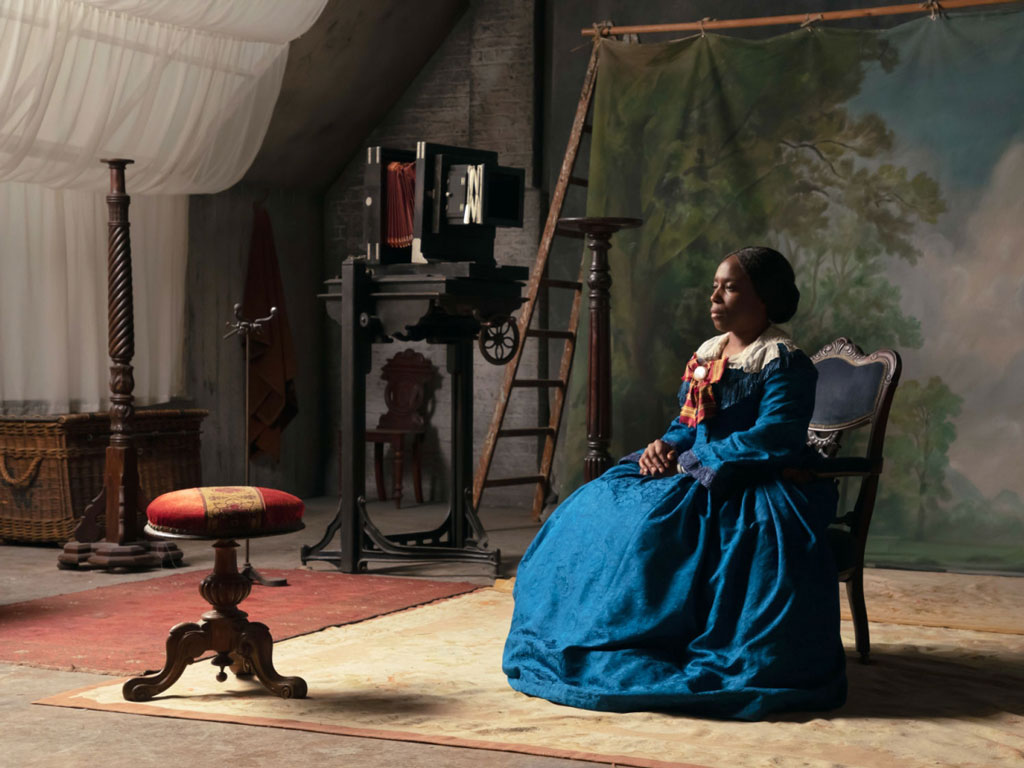ART-PRESENTATION: Isaac Julien-Lessons of the Hour
 Isaac Julien examines the black and Asian diasporas since the Thatcher years through his favoured medium, film. In 1983 he cofounded the British Sankofa Film and Video Collective. In 1995 he made a documentary series for television, The Question of Equality, about the history of the gay and lesbian movement in the United States. As well as looking at issues of gender and race, Julien uses different film and music sources in his work, which he recycles and remixes. He also interprets the exhibition format using multiple screens and special sound effects, creating a fluid space in which images and sound transcribe migration and the diaspora.
Isaac Julien examines the black and Asian diasporas since the Thatcher years through his favoured medium, film. In 1983 he cofounded the British Sankofa Film and Video Collective. In 1995 he made a documentary series for television, The Question of Equality, about the history of the gay and lesbian movement in the United States. As well as looking at issues of gender and race, Julien uses different film and music sources in his work, which he recycles and remixes. He also interprets the exhibition format using multiple screens and special sound effects, creating a fluid space in which images and sound transcribe migration and the diaspora.
By Dimitris Lempesis
Photo: Scottish National Gallery Archive
The UK and European premiere of Isaac Julien’s visionary ten-screen film installation “Lessons of the Hour”, offers a poetic meditation on the life and times of Frederick Douglass, the visionary African American orator, philosopher, intellectual, and self-liberated freedom-fighter, who was born into slavery in Maryland, USA. After escaping slavery in Maryland, Frederick Douglass gained celebrity on the abolitionist circuit as an extraordinary orator, becoming the most photographed American of the 19th Century. Julien’s project is informed by some of Douglass’s most important speeches, such as “Lessons of the Hour”, “What to the Slave Is the 4th of July?” and “Lecture on Pictures,” the latter being a text that connects picture-making and photography to his vision of how technology could influence human relations. Julien’s work gives expression to the zeitgeist of Douglass’s era, his legacy, and the ways in which his story may be viewed through a contemporary lens. Julien’s film imagines the person of Frederick Douglass through a series of tableaux vivants and gives life to his relationships with other cultural icons of the time. Mostly women, these characters were chosen for being representatives of ideals of equality and include African-American photographer J.P. Ball; Douglass’s wives Anna Murray and Helen Pitts; Anna and Ellen Richardson, the English Quakers who allowed Douglass to return to the United States as a free man; Susan B. Anthony, the suffragist and Douglass’s longtime friend; and Ottilie Assing, German intellectual, activist, and Douglass’s lover. Employing both 35mm film and the latest 4K digital technology, the film was shot in Washington, D.C., where Douglass lived late in life and where in 1894 he gave his final speech, “Lessons of the Hour” which addressed the shocking phenomenon of lynching in the post-Civil War American South. Additional filming took place in Scotland and England, where Douglass delivered over four hundred anti-slavery speeches; several of which Julien had reenacted inside the period rooms of the Royal Academy of Arts in London. The exhibition includes four tintype portraits of characters who are featured in “Lessons of the Hour”: Frederick Douglass, J.P. Ball, and Anna Murray Douglass. The series is titled “Lyrics of Sunshine and Shadow” after a poem by Paul Laurence Dunbar, whom Douglass once said was “the most promising colored man in America”. To create the works Julien had a tintype camera and developing facility on the film set provided by photographer Rob Ball, who produced the tintypes for the “Lessons of the Hour” project. Additionally, the exhibition features a selection of color photographs from the film, a number of found archival images that appear in the film.
Photo: Isaac Julien Lessons of the Hour (Lessons of the Hour), 2019, Framed photograph on matt arc hival paper, mounted on aluminium, 160 x 213.29 cm; 63 x 84 in, © Isaac Julien, Courtesy the artist and Jessica Silverman Gallery-San Francisco; Metro Pictures-New York; Victoria Miro-London/Venice
Info: Scottish National Gallery of Modern Art (Modern One), 75 Belford Road, Edinburgh, Scotland, Duration: 29/7-10/10/2021, Days & Hours: Sun-Tue 10:00-17:00, www.nationalgalleries.org






